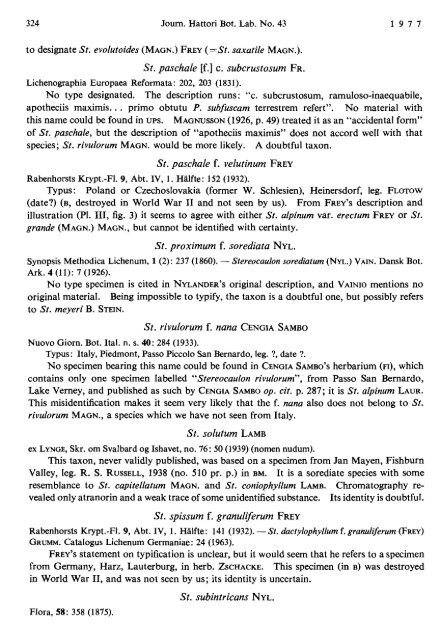A CONSPECTUS OF THE LICHEN GENUS STEREOCAULON ...
A CONSPECTUS OF THE LICHEN GENUS STEREOCAULON ...
A CONSPECTUS OF THE LICHEN GENUS STEREOCAULON ...
Create successful ePaper yourself
Turn your PDF publications into a flip-book with our unique Google optimized e-Paper software.
324 Journ. Hattori Bot. Lab. No. 43<br />
to designate St. evolutoides (MAGN.) FREY (=St. saxatile MAGN.).<br />
St. paschale [f.] c. subcrustosum FR.<br />
Lichenographia Europaea Reformata: 202, 203 (1831).<br />
No type designated. The description runs: "c. subcrustosum, rarnuloso-inaequabile,<br />
apotheciis maximis. . . primo obtutu P. subfuscam terrestrem refert". No material with<br />
this name could be found in ups. MAGNUSON (1926, p. 49) treated it as an "accidental form"<br />
of St. paschale, but the description of "apotheciis maximis" does not accord well with that<br />
species; St. rivulorum MAGN. would be more likely. A doubtful taxon.<br />
St. paschale f. velutinum FREY<br />
Rabenhorsts Krypt.-F1. 9, Abt. IV, 1. Halfte: 152 (1932).<br />
Typus: Poland or Czechoslovakia (former W. Schlesien), Heinersdorf, leg. FLOTOW<br />
(date?) (B, destroyed in World War I1 and not seen by us). From FREY'S description and<br />
illustration (PI. 111, fig. 3) it seems to agree with either St. alpinurn var. erectum FREY or St.<br />
grande (MAGN.) MAGN., but cannot be identified with certainty.<br />
St. proximum f. sorediata NYL.<br />
Synopsis Methodica Lichenum, 1 (2): 237 (1860). - Stereocaulon sorediatum (NYL.) VAIN. Dansk Bot.<br />
Ark. 4 (1 1): 7 (1926).<br />
No type specimen is cited in NYLANDER'S original description, and VAINIO mentions no<br />
original material. Being impossible to typify, the taxon is a doubtful one, but possibly refers<br />
to St. meyeri B. STEIN.<br />
St. rivulorum f. nana CENGIA SAMBO<br />
Nuovo Giorn. Bot. Ital. n. s. 40: 284 (1933).<br />
Typus: Italy, Piedmont, Passo Piccolo San Bernardo, leg. ?, date ?.<br />
No specimen bearing this name could be found in CENGIA SAMBO'S herbarium (FI), which<br />
contains only one specimen labelled "Stereocaulon rivulorum", from Passo San Bernardo,<br />
Lake Verney, and published as such by CENGIA SAMBO up. cit. p. 287; it is St. alpinum LAUR.<br />
This misidentification makes it seem very likely that the f. nana also does not belong to St.<br />
rivulorum MAGN., a species which we have not seen from Italy.<br />
St. solutum LAMB<br />
ex LYNGE, Skr. om Svalbard og Ishavet, no. 76: 50 (1939) (nomen nudum).<br />
This taxon, never validly published, was based on a specimen from Jan Mayen, Fishburn<br />
Valley, leg. R. S. RUSSELL, 1938 (no. 510 pr. p.) in BM. It is a sorediate species with some<br />
resemblance to St. capitellatum MAGN. and St. coniophyllum LAMB. Chromatography revealed<br />
only atranorin and a weak trace of some unidentified substance. Its identity is doubtful.<br />
St. spissum f. granuliferum FREY<br />
Rabenhorsts Krypt.-F1. 9, Abt. IV, 1. Halfte: 141 (1932). - St. dactylophyllum f. granuliferum (FREY)<br />
GRUMM. Catalogus Lichenum Germaniae: 24 (1963).<br />
FREY'S statement on typification is unclear, but it would seem that he refers to a specimen<br />
from Germany, Harz, Lauterburg, in herb. ZSCHACKE. This specimen (in B) was destroyed<br />
in World War 11, and was not seen by us; its identity is uncertain.<br />
Flora, 58: 358 (1875).<br />
St. subintricans NYL.

















